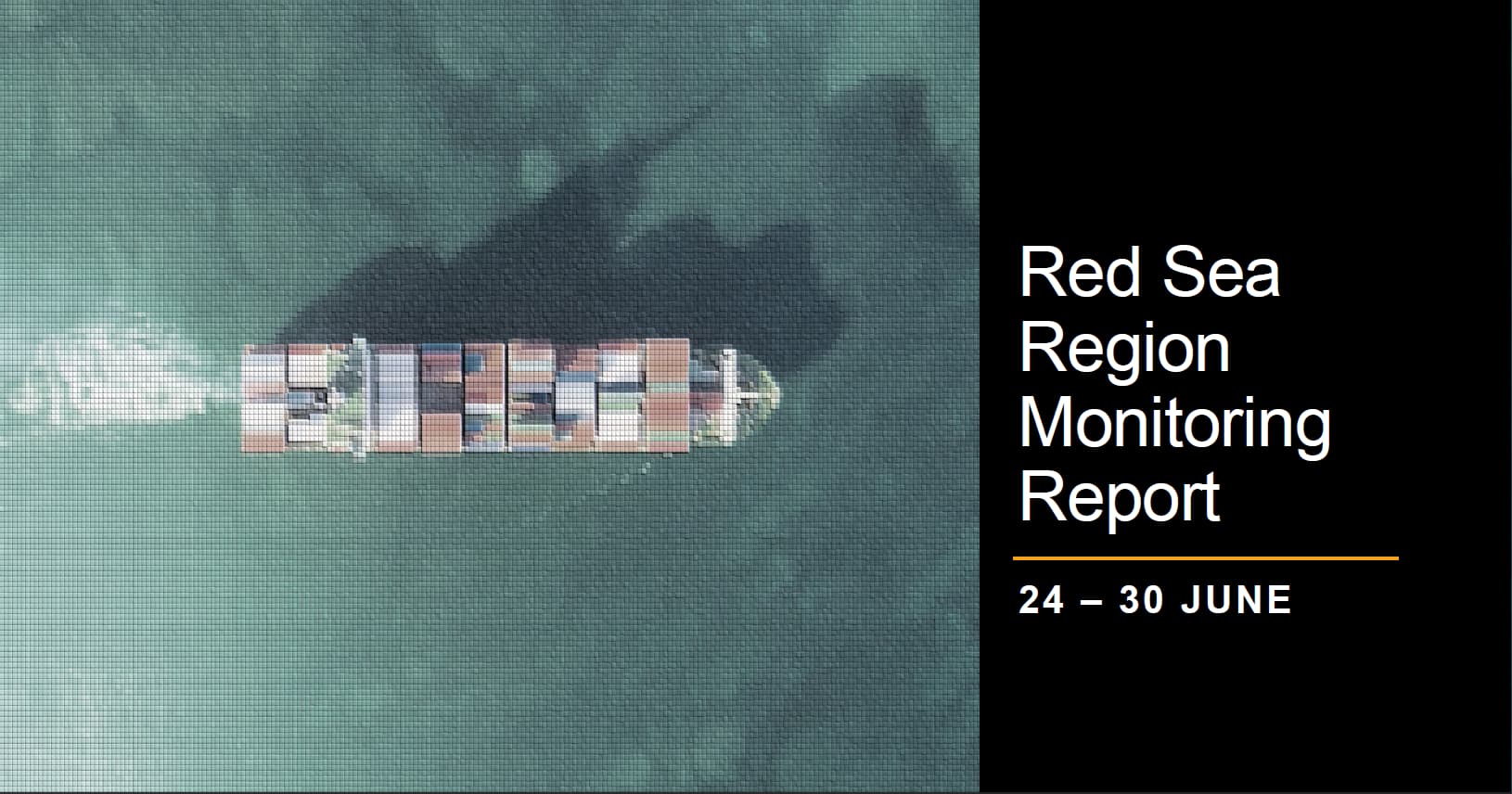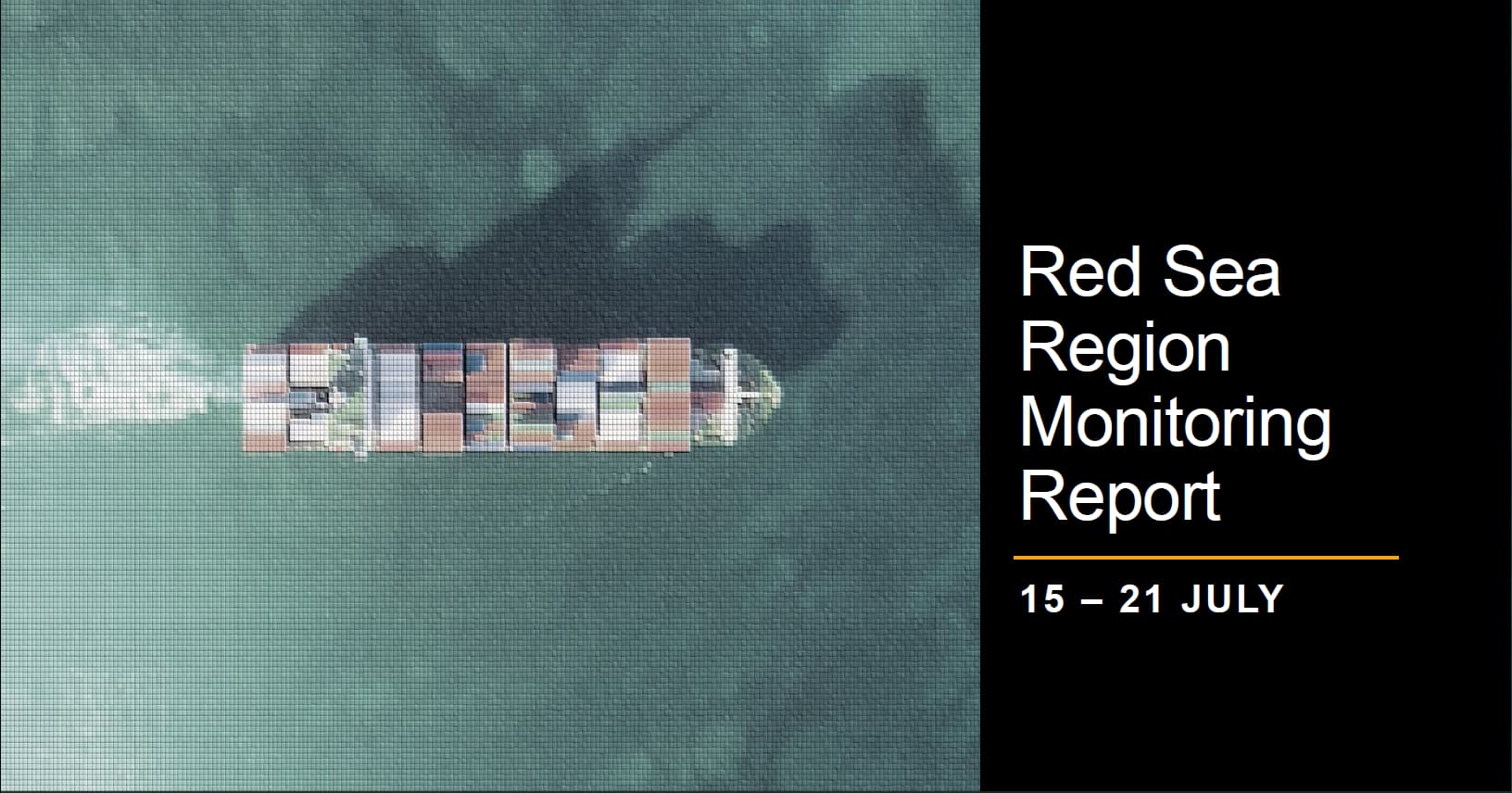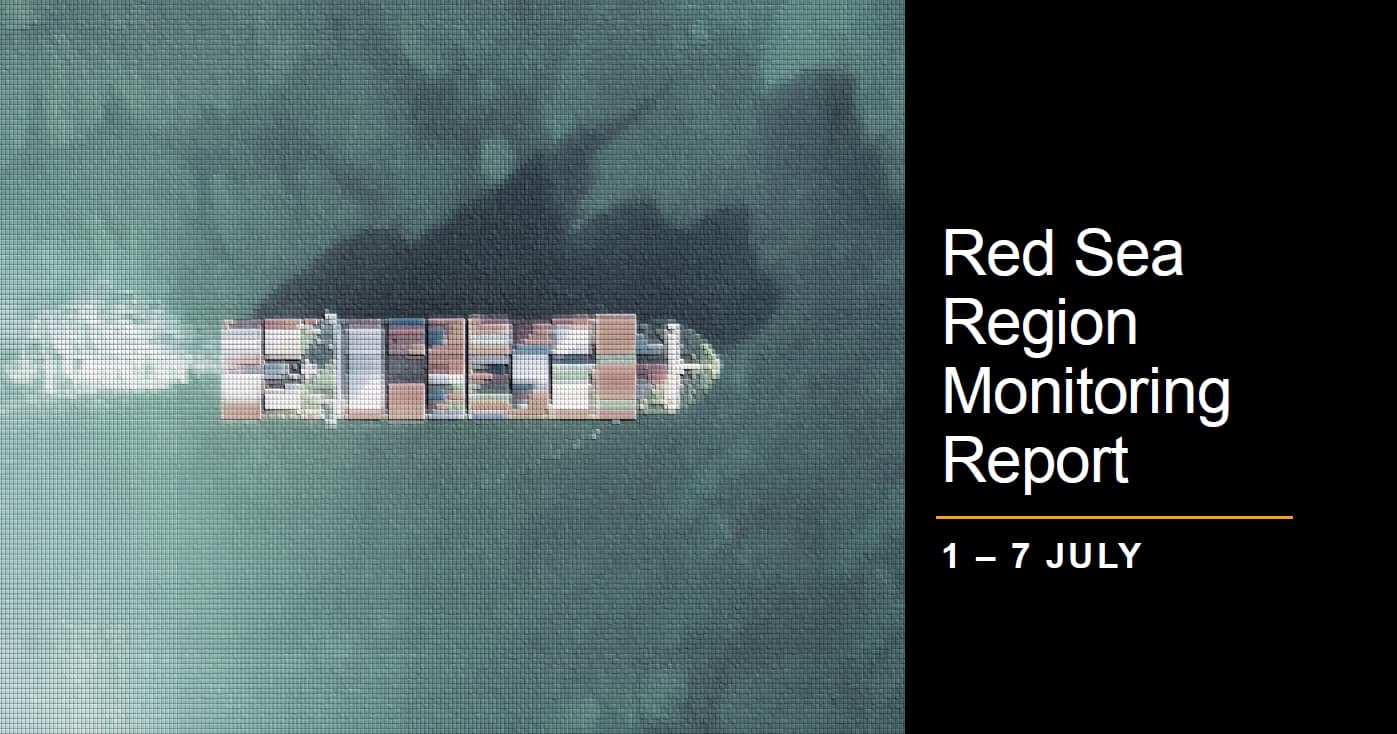KEY DEVELOPMENTS – COMMERCIAL INCIDENTS
During the monitoring period 3 – 9 June Regal Maritime Solutions (RMS) identified the following incidents in the Red Sea and Gulf of Aden region:
MISSILE ATTACK: On 5 June. a major explosion occurred a short distance on the port side of a merchant vessel, approximately 50NM southwest of Al Shuqaiq, Saudi Arabia in the Red Sea. Upon inspection no damaged was identified on the vessel and it proceeded to its next port of call.
MISSILE ATTACK: On 6 June, a commercial vessel, the AAL Genoa, reported that two explosions occurred in close proximity to the vessel approximately 27NM in south of Al Mukha, Red Sea in the Bab el-Mandeb strait. No damage was reported, and crew reported safe. The vessel proceeded to its next port of call.
MISSILE STRIKE: On the evening 8 June, a vessel was struck by two missiles approximately 80NM southeast of Aden, resulting in a fire in the mooring station. The fire was extinguished, and the vessel proceeded to its next port of call.
MISSILE STRIKE: On 9 June a vessel was struck by a missile on the aft section, resulting in a fire. The incident occurred 70NM southwest of Aden. The vessel initiated damage control procedures and continued to its next port of call.
MISSILE STRIKE: On 9 June, a commercial vessel was reportedly struck by a missile approximately 89NM southwest of Aden, Yemen. No casualties were reported, and the vessel continued to its next
IRANIAN INTELLIGENCE VESSEL: The Iranian intelligence vessel, the Behshad was reported on 2 June in the vicinity of Bostanu port in the Persian Gulf in Iranian territorial waters.

KEY DEVELOPMENTS – MILITARY ACTIVITY
During the monitoring period 3 – 9 June RMS identified the following incidents involving US coalition forces in the Red Sea and Gulf of Aden region, obtained from military and open sources:
MISSILE ATTACK: On 4 June, US forces identified two anti-ship ballistic missiles (ASBM) that had been launched by Houthi militants from Houthi-controlled areas of Yemen into the Red Sea. No injuries or damage reported by US, coalition, or commercial ships.
UAV INTERCEPT: On 6 June. US forces destroyed eight Houthi uncrewed aerial vehicles (UAV) launched from Houthi-controlled areas of Yemen over the Red Sea.
USV INTERCEPT: On 6 June. the US Navy successfully destroyed two Houthi uncrewed surface vessels (USV) in the Red Sea.
UAV INTERCEPT: On 6 June, a coalition ship successfully engaged one UAV launched from a Houthi controlled area of Yemen over the Red Sea.
MISSILE ATTACK: On 6 June, Houthis militants also launched one anti-ship ballistic missile (ASBM) from a Houthi controlled area of Yemen over the Red Sea, with no reported injuries or damage to US, coalition of commercial ships.
MISSILE ATTACK: On 7 June, Houthis militants launched four anti-ship ballistic missiles (ASBM) from Houthi controlled areas of Yemen over the Red Sea. No injuries or damage reported by vessels in the region.
UAV/MISSILE INTERCEPT: On 7 June, US forces successfully destroyed four UAVs and two ASBMs in Houthi controlled areas of Yemen. This was in addition to one UAV destroyed over the Bab al-Mandab Strait launched from a Houthi controlled area of Yemen.
HOUTHI PATROL VESSEL DESTROYED: On 7 June, US forces successfully destroyed a Houthi patrol boat in the Red Sea, considered an imminent threat to vessels in the region.
MISSILE ATTACK: On 9 June, Houthi militants launched two anti-ship ballistic missiles (ASBM) from Houthi controlled areas of Yemen into the Gulf of Aden. One ASBM struck the MV TAVVISHI, a Liberian-flagged, Swiss owned and operated container ship, which reported damage but continued its voyage. The second ASBM was successfully destroyed by a coalition ship. There were no reported injuries. Whilst Houthi militants claimed the attack occurred in the Arabian Sea, no evidence was provided to confirm the claim, with tracking data suggesting the vessel to have been in the Gulf of Aden when the attack occurred.
MISSILE ATTACK: On 9 June, Houthi militants launched one ASBM and one anti-ship cruise missile (ASCM) into the Gulf of Aden with both hitting the MV NORDENEY, an Antigua and Barbados flagged, German owned and operated cargo ship. The vessel reported damage but continued on its voyage. There were no injuries. A Houthi spokesperson confirmed the vessel had been targeted with both missiles and UAVs.
UAV/MISSILE INTERCEPT: On 9 June, US forces successfully destroyed one uncrewed aerial vehicle (UAV) over the Gulf of Aden. This was later followed by a US strike on two Houthi land attack cruise missiles (LACM) and one missile launcher in Houthi- controlled areas of Yemen, considered an imminent threat to shipping in the area.
KEY DEVELOPMENTS – HOUTHI MISSILE STATISTICS

Figures 1 and 2 identifies the number of missiles, UAV, USVs and UUVs launched, or prepared to be imminently launched, by Houthi militants from Yemen targeting commercial and naval vessels in the Red Sea and Gulf of Aden regions. Figures have incorporated statistics from vessels hit, near misses and pre- emptive strikes on-land in Yemen by US-led Coalition forces but not those resulting from large scale coordinated military action. In some cases the destined target of Houthi weapons including destroyed on-land in Yemen cannot not be verified and has therefore been categorised as ‘Not Known’ (NK). Where no dates are provided there were no reported incidents or data available for that period.
ANALYSIS: The monitoring period saw an uptick in Houthi missile and UAV attacks, which proved more consistent compared to previous weeks which appeared to b more sporadic in comparison. The Houthis also appeared to have had greater success in striking commercial vessels in both the Red Sea and Gulf of Aden despite US and coalition warships operating in the region and continuing to provide air defense for vessels transiting the maritime corridor. The Houthi’s appeared to have largely focused on targeting vessels in the Red Sea region at the beginning of the monitoring period before shifting towards targets in the Gulf of Aden more recently.
KEY DEVELOPMENTS – SECURITY INCIDENT MAPPING


REGIONAL DEVELOPMENTS
During the monitoring period 3 – 9 June RMS identified the following key regional developments:
Yemen’s Houthi militants unveiled a new solid-fuel missile that resembles an earlier displayed missile by Iran, which was claimed could fly at hypersonic speeds. The missile called Palestine, was reportedly launched at the port of Eilat, Israel on 4 June. The missile was successfully intercepted and no harm or damage was caused as a result.
On 5 June, Israel indicated it was prepared to launch a large-scale attack on Lebanon as to deter the Iran backed Islamist group Hezbollah, increasing tensions and potential of conflict spillover further into Lebanon.
On 7 June Houthi militants claimed to have attacked the of a 7 June the container ship the ELBELLA, however the claims remain unverified.
On 8 June in Nuseirat, Gaza, the Israeli Defense Force (IDF) conducted a successful hostage rescue operation, freeing four hostages. One IDF soldier died during the operation. Hamas-affiliated sources claim the operation killed 210 Palestinians.
On 9 June, Hezbollah launched anti-aircraft missiles at IDF fighter jets flying over southern Lebanon. This is the first time the group have used anti-aircraft weaponry since the beginning of the conflict in October 2023.
On 9 June, Israeli War Cabinet member Benny Gantz announced his resignation from the war cabinet. Gantz ha previously threatened to leave the cabinet by 8 June unless Prime Minister Benjamin Netanyahu advanced plans for Gaza’s post war governance. In his resignation speech, Gantz accused Netanyahu of preventing Israel from achieving true victory.
On 9 June, Knesset member, and War Cabinet observer Gadi Eisenkot left his post in the war cabinet, alleging the cabinet was “paralysed by outside considerations” regarding its conduct in the ongoing conflict.
On 9 June, Israeli National Security Minister Itamar Bengvir demanded a seat in the War Cabinet to replace former member Benny Gantz.
On 9 June, the US resumed air dropping aid into northern Gaza, with a US cargo plane dropping 10 metric tonnes of aid onto the area. However the UN World Food Programme announced it would halt aid deliveries to Gaza via the US- built pier due to ‘security concerns’.
On 9 June, nine Yemeni UN employees were arrested by Houthi officials on suspected spy charges. The employees are believed to have been operating for the US and Israeli intelligence services.
US Secretary of State Antony Blinken will visit the Middle East on 10-12 June where he intends to visit Egypt, Israel, Qatar and Jordan, in an attempted to pressure Hamas to accept the ceasefire deal proposed by US President Joe Biden.
ASSESSMENT
• Further aerial assaults by Houthi militants are likely in the coming days, mostly in the southern Red Sea and the Gulf of Aden, but there may be a limited number of attempts to target vessels in the Indian Ocean. Successful Houthi long-range attack in the Indian Ocean is low compared to vessels targeted in the Red Sea and Gulf of Aden.
• Increased coordination is expected between Iran and axis of resistance members in particular with Hezbollah and armed groups operating from Syria, demonstrated by the Iranian Foreign Minister’s visits to the countries.
• Vessels voyaging through the Red Sea and Gulf of Aden is at a high risk of vessel damage from Houthi aerial attacks; whilst vessels passing through the Indian Ocean and near the Somali coastline is at heightened risk of being targeted by pirate action groups (PAG).
• Vessels linked to Israel, the US and UK will remain primary, but not sole targets for Houthi militants. Houthi use of inaccurate data and intelligence pertaining to target identification, and/or maintaining an effective command and control procedure with local units, places non Israeli, US and UK vessels at a risk of being misidentified, including Russian and Chinese linked vessels.
• Any ceasefire between Israel and Hamas, may see a temporary pause in attacks.
• The US and its partners will continue to conduct pre-emptive strikes against Houthi targets on-land in an attempt to degrade Houthi military capability and prevent it to be used to target commercial shipping and from being used as a platform to target Israel.
• The US will continue its efforts to intercept vessels smuggling weapon components from Iran to the Houthis in Yemen and enhance its intelligence collection methods to support
interdiction operations, as well as coordinate military strikes against Houthi weapon sites, facilities and capabilities.
• The US government will continue to push for a diplomatic solution for the Israel-Hamas conflict with regional partners due to the ongoing humanitarian crisis in Gaza and attempt to prevent escalatory military activity by the Israeli government in Rafah which may heighten the risk to civilians.
RECOMMENDATIONS
• Merchant and other vulnerable vessels are recommended to register with the Maritime Security Centre – Horn of Africa’s Voluntary Registration Scheme due to heightened piracy threat in the Indian ocean.
• Avoid being in vicinity of Iranian Behshad vessel. Avoid where possible transiting locations within the UAE and Iranian coastlines due to the risk from Iranian military boarding parties.
• Vessels operating in the Indian Ocean area are urged to heighten their vigilance due expanded risk area from Houthi missile and UAV attack and continued threat from Pirate Activity Groups (PAGs) in the area.
• Report any Suspicious Sightings and be aware of the risk of Unmanned aerial Vehicle (UAV) / drone and Uncrewed Surface Vehicle (USV) attack.
• Consider utilising a digital monitoring system, which incorporates UAV/UUV drone monitoring to warn of potential attack and use of physical barriers, such as nets and underwater barriers, that can be deployed to prevent UUVs from approaching a ship. These barriers can entangle or obstruct the movement of a UUV..
• Ensure crew conduct drills and training exercises to respond to UUV threats so that they are well-prepared to take appropriate action in the event of an incident.
• Follow guidance on loitering munitions as per the OCIMF website: https://www.ocimf.org/publications/information-papers/loitering-munitions-%E2%80%93-the-threat-to-merchant-ships
• Implement and review BMP5 in particular section 2, which describes non-piracy threats and the Global Anti-Piracy Guide.
• Consider mentioning vessel location to Flag Authorities.
• Inform UKMTO/MSCHoA of vessel movements and ensure radar is kept on.
• Communicate with local agents for any local information or intelligence.
• Keep VHF Ch16 on and pay attention to advisories. Ensure strict surveillance of communications and establish communication with all approaching vessels.
• Do not allow small boats to approach or dock. Consider utilizing an armed security team aboard.
• Ensure there is Hard Cover available if on deck and that it is accessible.
• Ensure a Secondary Muster Station is considered and identified to crew and not just the citadel.
• Maintain Bridge Watches. (Please be aware at night, small, slow vessels without a wake are difficult to detect on radar). Keep Traffic on Upper Deck to a minimum
• Ensure all fire-fighting equipment is checked and available for immediate use. Including the emergency fire pump and that relevant maintenance has been conducted.





